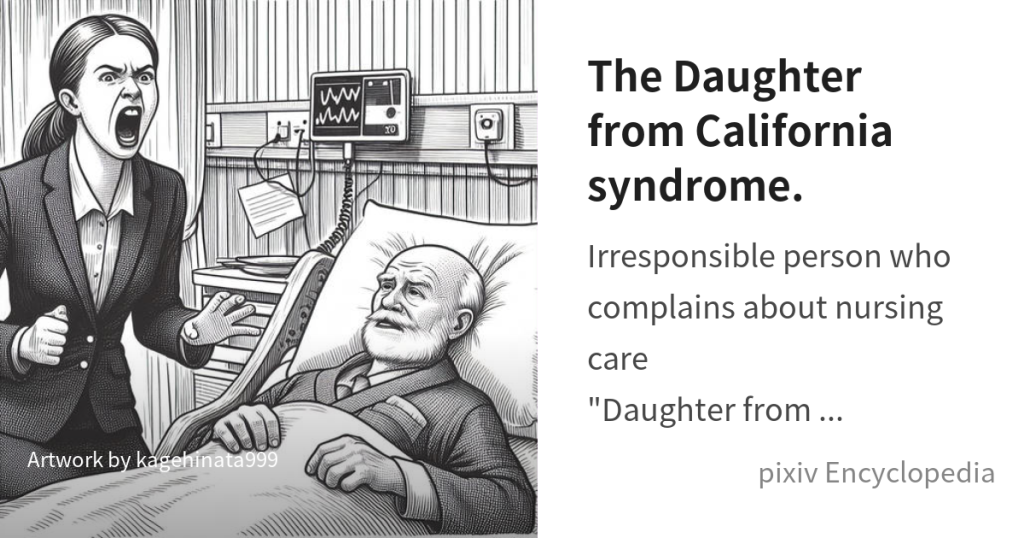In the ever-evolving landscape of healthcare, certain terms emerge that reflect the complexities of patient care, family dynamics, and ethical dilemmas. One such term is “Daughter From California Syndrome.” This phrase, though seemingly specific, has become a symbol of broader issues in end-of-life care and family involvement in medical decisions. In this article, we delve into the origins, implications, and significance of this phenomenon.
The Origins of the Term

The term “Daughter From California Syndrome” was first documented in a 1991 case report published in the Journal of the American Geriatrics Society. The paper, titled “Decision Making in the Incompetent Elderly: ‘The Daughter from California Syndrome’,” was authored by David Molloy and colleagues. It aimed to provide strategies for medical staff dealing with difficult family members of mentally incompetent patients.
According to the reference text, the “Daughter from California” is often described as angry, articulate, and uninformed. These characteristics are not merely stereotypes but highlight a pattern observed in medical settings where long-lost relatives suddenly appear at the bedside of a dying elderly patient, challenging the care being provided or demanding aggressive life-prolonging measures.
Understanding the Phenomenon
Medical professionals have noted that individuals labeled as “Daughter from California” often have been absent from the life and care of the elderly patient. This absence can lead to surprise at the scale of the patient’s deterioration and unrealistic expectations about what is medically feasible. Feelings of guilt and denial may drive these individuals to reassert their role as caregivers, sometimes at the expense of the patient’s best interests.
In his 2015 book The Conversation: A Revolutionary Plan for End-of-Life Care, American doctor Angelo Volandes attributes this behavior to “guilt and denial,” rather than what is necessarily best for the patient. This perspective underscores the emotional and psychological dimensions of the syndrome, highlighting the need for sensitive and informed communication between medical teams and families.
The Impact on Healthcare Providers
For healthcare providers, managing situations involving “Daughter From California” can be challenging. The sudden appearance of a relative who has been absent from the patient’s life can disrupt the care plan and create tension within the medical team. It requires not only clinical expertise but also strong interpersonal skills to navigate these complex interactions.
Healthcare professionals must balance the desire to respect the patient’s autonomy with the need to ensure that decisions align with the patient’s values and preferences. This balancing act becomes even more complicated when family members have conflicting views or unrealistic expectations about the patient’s condition.
Legal and Ethical Considerations
The legal and ethical dimensions of “Daughter From California Syndrome” are significant. In the United States, there are ongoing debates about the proper venues, standards of evidence, and presumptions to be employed when determining the wishes, values, and best interests of patients who are incapable of expressing their own views regarding their medical care.
Position statements from organizations like the American Academy of Neurology (AAN) emphasize the importance of respecting a patient’s autonomy and wishes, whether those wishes are to continue or discontinue therapies. These discussions highlight the need for clear policies and guidelines to support healthcare providers in making decisions that align with the patient’s best interests.
Cultural and Regional Variations
Interestingly, the term “Daughter From California” is not unique to California. In California, it is known as the “Daughter from New York,” and in Canada, it is referred to as the “Daughter from Ontario.” These regional variations suggest that the phenomenon is not confined to a single geographic area but reflects broader cultural attitudes toward family involvement in medical decision-making.
This cultural context is crucial for understanding how different communities approach end-of-life care. It underscores the importance of culturally competent care, where healthcare providers are aware of and sensitive to the diverse values and beliefs of their patients and their families.
The Role of Communication
Effective communication is key in managing situations involving “Daughter From California.” Open, honest, and empathetic dialogue between healthcare providers and family members can help clarify the patient’s wishes and reduce misunderstandings. It is essential for healthcare professionals to educate family members about the patient’s condition, treatment options, and the potential outcomes of various decisions.
Moreover, involving the patient in the decision-making process, whenever possible, is vital. This includes discussing advance directives, living wills, and other legal documents that outline the patient’s preferences for medical care. Such measures can help prevent conflicts and ensure that the patient’s voice is heard.
The Broader Implications
While “Daughter From California Syndrome” may seem like a niche topic, its implications extend far beyond individual cases. It reflects broader societal issues related to aging, family dynamics, and the ethics of end-of-life care. As the population ages, these issues will become increasingly relevant, requiring thoughtful and compassionate approaches from healthcare providers, policymakers, and the public.
The phenomenon also raises important questions about the role of family in healthcare decisions. While family involvement can provide valuable insights and support, it can also introduce challenges that require careful navigation. Balancing the needs and perspectives of all parties involved is essential for ensuring that the patient’s best interests are prioritized.
Conclusion
“Daughter From California Syndrome” is more than just a medical term; it is a reflection of the complex interplay between family, healthcare, and ethics. Understanding this phenomenon requires a nuanced approach that considers the emotional, cultural, and legal dimensions of end-of-life care. By fostering open communication, promoting cultural competence, and upholding the principles of patient autonomy, healthcare providers can better navigate these challenges and provide care that aligns with the patient’s values and preferences.
As we continue to grapple with the realities of an aging population and evolving healthcare practices, the lessons learned from “Daughter From California Syndrome” will remain relevant. They remind us of the importance of empathy, education, and ethical decision-making in ensuring that every patient receives the care they deserve.














More Stories
US Trending News: The ‘Your Mom’ White House: A Trendy Take on Political Humor
What Is Yodo Para Tiroides and How Does It Affect Thyroid Health?
Understanding ‘You Got That Right’ in The New York Times: Context and Implications